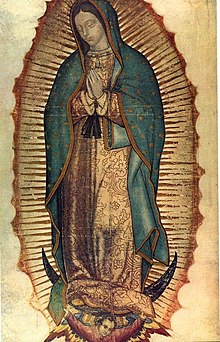Our website is made possible by displaying online advertisements to our visitors.
Please consider supporting us by disabling your ad blocker.
Our Lady of Guadalupe
19°29′04″N 99°07′02″W / 19.48444°N 99.11722°W
Our Lady of Guadalupe
| |
|---|---|
 | |
| Location | Tepeyac Hill, Mexico City |
| Date | December 9–12, 1531 O.S. (December 19–22, 1531 N.S.) |
| Witness | |
| Type | Marian apparition |
| Approval | October 12, 1895 (canonical coronation granted by Pope Leo XIII) |
| Venerated in |
|
| Shrine | Basilica of Our Lady of Guadalupe, Tepeyac Hill, Mexico City, Mexico |
| Patronage |
|
| Attributes | A pregnant woman, eyes downcast, hands clasped in prayer, clothed in a pink tunic robe covered by a cerulean mantle with a black sash, emblazoned with eight-point stars; eclipsing a blazing sun while standing atop a darkened crescent moon, a cherubic angel carrying her train |
| Feast day | December 12 |

Our Lady of Guadalupe (Spanish: Nuestra Señora de Guadalupe), also known as the Virgin of Guadalupe (Spanish: Virgen de Guadalupe), is a Catholic title of the Blessed Virgin Mary associated with four Marian apparitions to Juan Diego and one to his uncle, Juan Bernardino reported in December 1531, when the Mexican territories were part of the Spanish Empire.
A venerated image on a cloak (tilmahtli) associated with the apparition is enshrined in the Basilica of Our Lady of Guadalupe in Mexico City.
Pope Leo XIII granted a decree of canonical coronation for the image on 8 February 1887. The rite of coronation was executed by the former Archbishop of Mexico, Próspero Alarcón y Sánchez de la Barquera on 12 October 1895. Pope Paul VI raised the shrine to the status of Minor Basilica via his Pontifical decree titled Sacra illa Ædes on 6 October 1976 and is the most-visited Catholic shrine in the world, and the world's third most-visited sacred site.[3][4]
- ^ Cite error: The named reference
Johnson2015was invoked but never defined (see the help page). - ^ "Iglesia Episcopal Anglicana de Chile". Instagram. Retrieved December 13, 2023.
- ^ "World's Most-Visited Sacred Sites", Travel and Leisure, January 2012
- ^ ""Shrine of Guadalupe Most Popular in the World", Zenit, June 13, 1999". Archived from the original on May 7, 2016. Retrieved June 12, 2009.
Previous Page Next Page
السيدة غوادالوبي Arabic Our Lady of Guadalupe BCL Маці Божая Гвадэлюпская BE-X-OLD Nostra Senyora de Guadalupe Catalan Birhen sa Guadalupe CEB Panna Maria Guadalupská Czech Unsere Liebe Frau von Guadalupe German Nia Damo de Gvadalupo EO Nuestra Señora de Guadalupe (México) Spanish Guadalupen neitsyt Finnish


